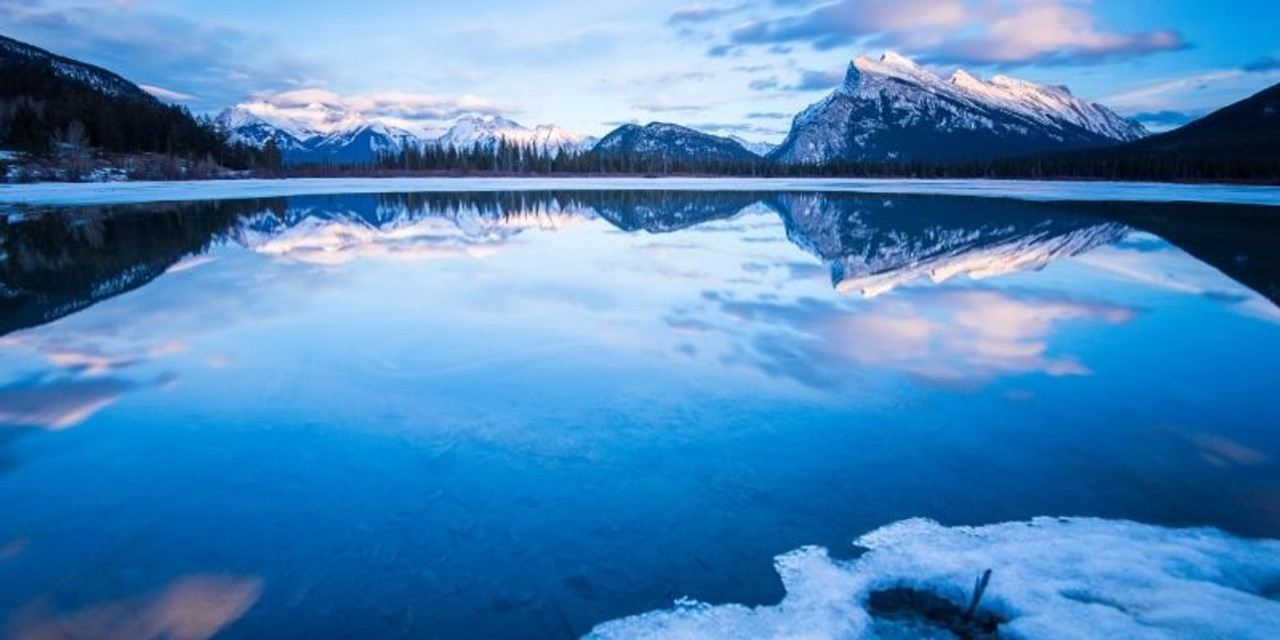Snowshoeing Banff
Posted by Crescent Moon on Mar 10th 2020
The soaring, streaked, and sky-shredding peaks of the Canadian Rockies—the Main and Front ranges of them, specifically—give Banff National Park in Alberta some of the most glorious scenery in the world, bar none. This internationally renowned park, which falls within the UNESCO Canadian Rocky Mountain Parks World Heritage Site, draws droves of tourists in high summer, but winter visitors find equally stunning sightlines and rich adventure.
Snowshoeing here is fantastic, whether you’re taking short front-country jaunts or heading out for multi-day backcountry odysseys. Besides the views of monstrous whitened peaks and iced-over glacial lakes, you’ve got the chance of seeing the tracks of some of Banff’s wild residents out on the snowshoe trails: from elk and moose to wolves, lynx—maybe even that elusive giant weasel the wolverine.
Here we’ve rounded up some of the more popular and accessible snowshoeing routes in Banff, which serve as great introductions to winter explorations in the park. Crescent Moon foam snowshoes are perfect for travel if you don't live near Banff and are built to withstand even the most rigorous snowshoe adventures.
Snowshoeing Banff: The Hoodoos Viewpoint
This roughly six-mile round-trip snowshoe out of the town of Banff gives you a look at some fascinating geological formations along the flanks of Tunnel Mountain. Trace the slopes above the Bow River, admiring the huge face of Mount Rundle on the other side, for a memorable view of the Hoodoos: pale sedimentary spires representing glacial till protected from erosion by resistant capping rocks.
Snowshoeing Banff: The Ink Pots via Moose Meadows
Another classic summertime destination in Banff that’s equally rewarding to take in amid winter snows, the Ink Pots are a cluster of spring-fed pools in a subalpine meadow above Johnston Canyon. You can get to this lovely basin via the Johnston Canyon Trail, a crowded peak-season boardwalk route and reasonably popular in winter due to dramatic ice formations, but beginning at Moose Meadows provides a quieter climb of about 3.5 miles one-way. The vivid ponds are lovely in their snow-and-ice guise, and meanwhile clear conditions afford spectacular views of the big surrounding peaks, including 9,541-foot Mount Ishbel in the Sawback Range.
Snowshoeing Banff: Taylor Lake
Across the valley of the Bow River from the Ink Pots heights, Taylor Lake nestles against the foot of 9,547-foot Mount Bell, making another of Banff’s gloriously scenic snowshoeing destinations. The roughly eight-mile trek is a challenging one, suitable for more advanced snowshoers.
Snowshoeing Banff: Lake Louise Lakeshore
Given the scenery, this extremely level trail along the northern shores of postcard-perfect Lake Louise must rank among the best beginner snowshoe ambles on the continent. This roughly 2.5-mile walk kicks off at the historic Chateau Lake Louise and proceeds along the snowbound fringe of this grand, mountain-walled glacial lake; you’ll be knocked out by the views, not least of the imposing, cliff-belted loom of Fairview Mountain—just past 9,000 feet tall—across the water. There’s also a heck of a turnaround point: the icicle-shaggy chute of Louise Falls, an ice-climbing magnet.
Snowshoeing Banff: Peyto Lake Viewpoint
In summer, you can drive to the mind bogglingly beautiful Peyto Lake Viewpoint, but in winter it makes a great (and easy) destination for snowshoers: less than a mile round trip’s walk from the Bow Summit parking area along the Icefields Parkway. This time of year, you won’t be able to see the famous turquoise hue of Peyto Lake—derived from the “glacial flour” suspended in its waters, product of the erosive work of the Peyto Glacier and Wapta Icefield that feed the lake—but the whitened version of the mountainscape vista, including Mistaya Mountain, remains one of the signature showstopper prospects in the Canadian Rockies.
Snowshoeing Banff Etiquette & Safety
When snowshoeing one of the Banff winter trails shared with cross-country skiers, don’t tromp along the established ski tracks: Share the routes respectfully!
The generous snowpack and severe relief of Banff’s mountains translate to significant avalanche hazard, and even if you’re not recreating on steep slopes you can be at risk: A snowshoer passing above or below an avalanche-prone slope, or even trekking on adjacent terrain, can unleash a slide, and the “runout zone” beneath avalanching slopes may extend well out onto level ground. So always monitor the avalanche forecast and check in with park officials and other authorities to steer clear of risky areas.
You should also always carry an avalanche probe, shovel, and beacon if you’re doing serious snowshoeing in the Banff backcountry, plus other winter recreation essentials.
Places to Stay While Snowshoeing Banff
If you want to extend your snowshoeing adventures in Banff, you’ve got some great options for overnight stays: Snowshoe into backcountry lodges such as Shadow Lake or Skoki, or call the hostels along the Icefields Parkway your base camp. And, of course, there’s also Chateau Lake Louise, one of the most iconic national-park hotels in the world.
